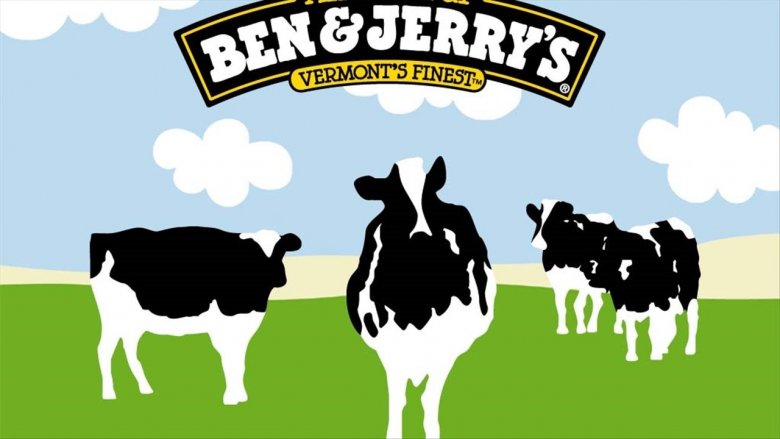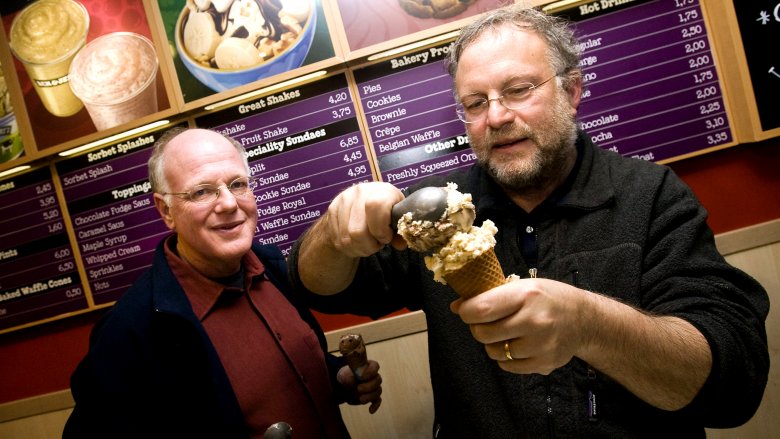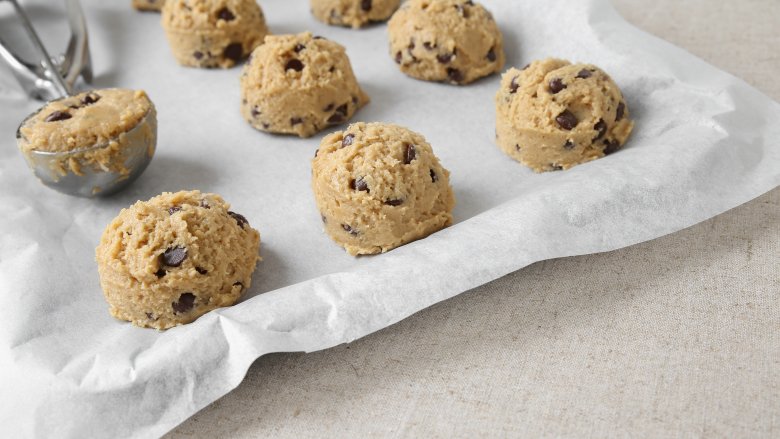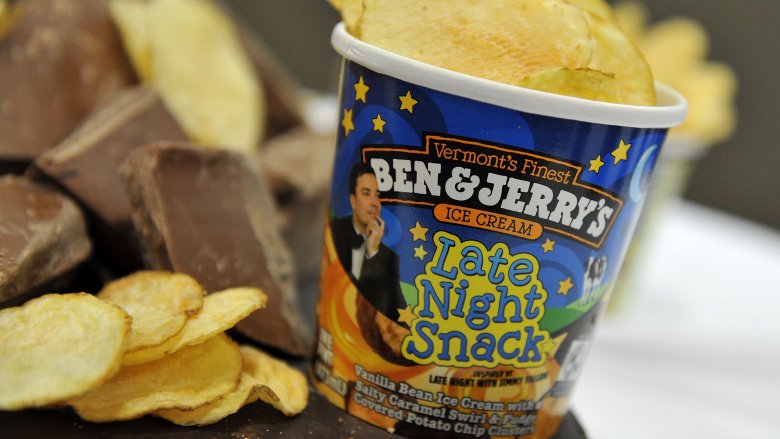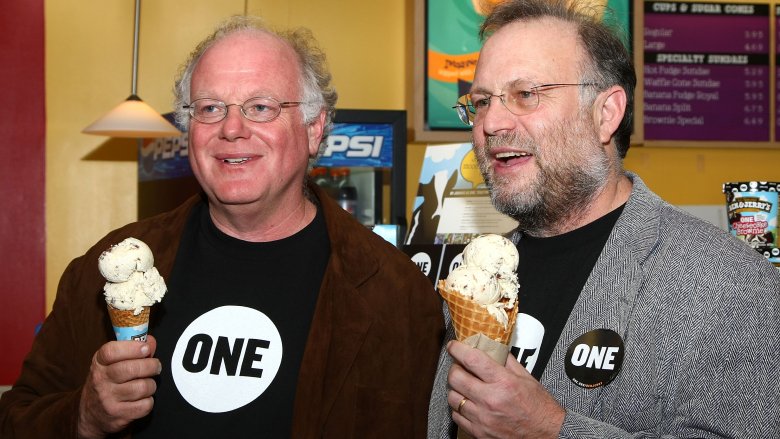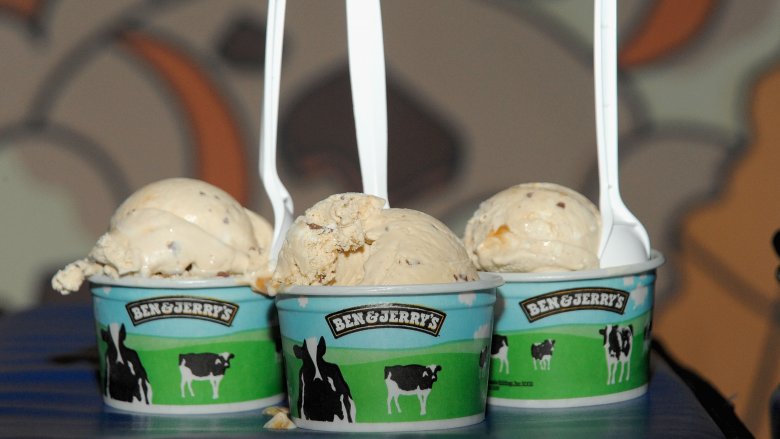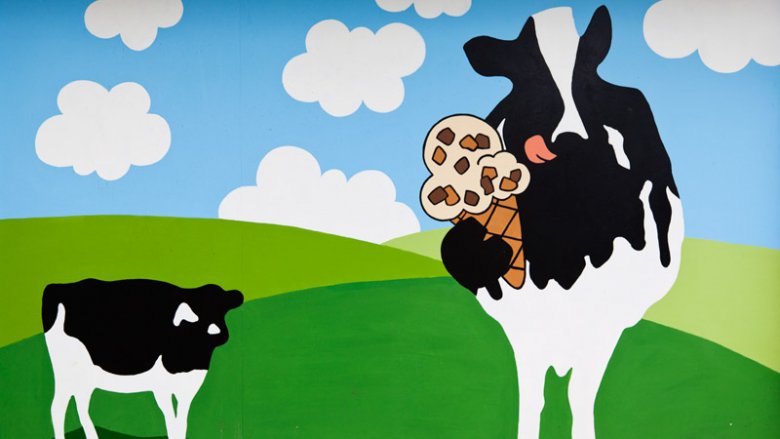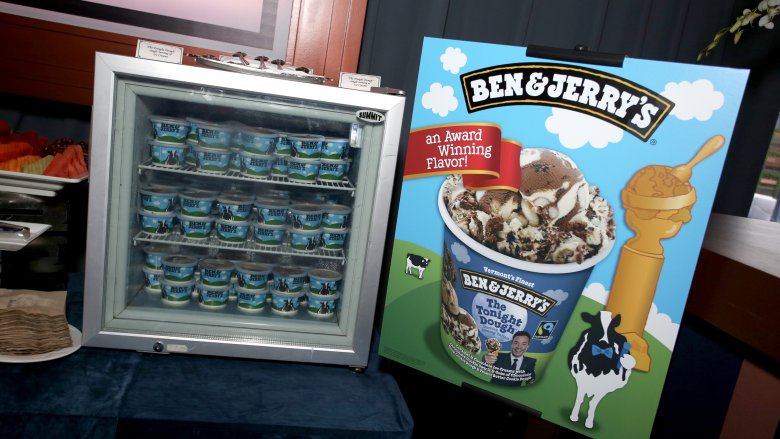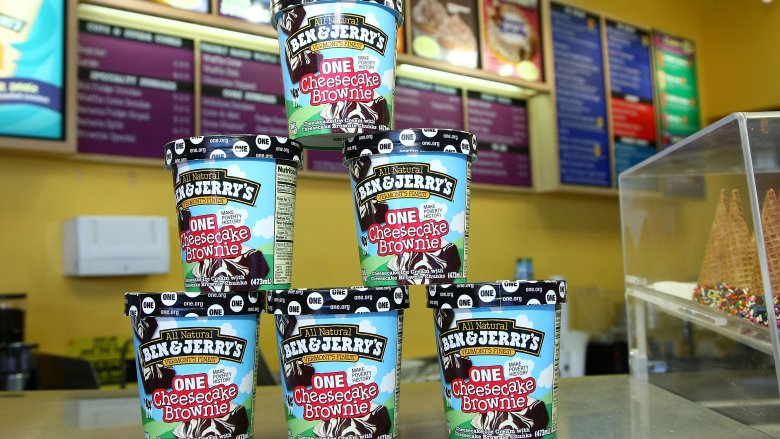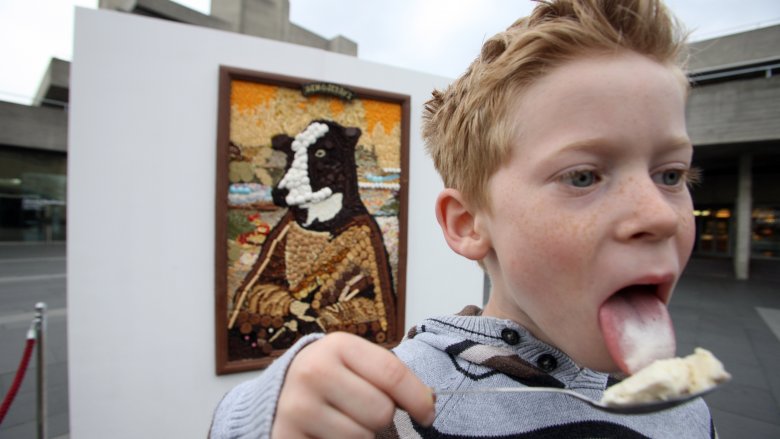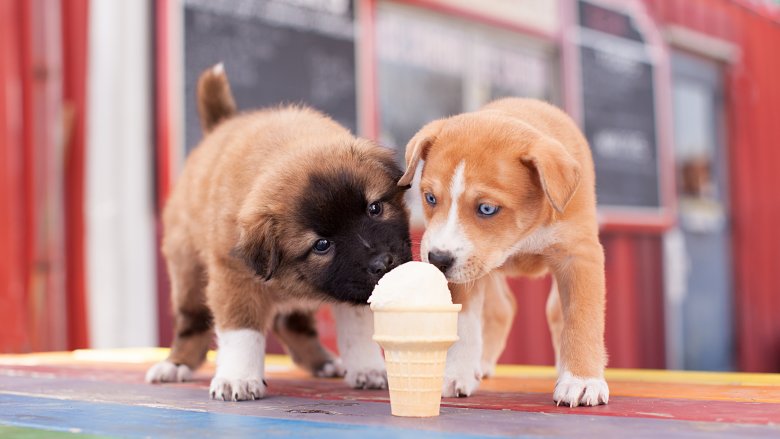The Untold Truth Of Ben & Jerry's
Grocery shopping can be tedious, but if there's one thing that always makes it better it's that pint of Ben & Jerry's ice cream that always seems to fall into the cart as a reward for getting your weekly shopping done. Whether you gravitate toward Chocolate Chip Cookie Dough, Chubby Hubby, or Chunky Monkey, you probably have your favorite flavor — you know, the one that makes you irrationally happy when you see it on the shelves. No matter how big of a fan you are, there's still a lot you probably don't know about this socially responsible company with the amazingly delicious product.
Their first flavor is still their best-selling, and it's not what you expect
Ben & Jerry's ice cream is all about the flavors. It's about the chunks of goodness, swirls of sauce, pieces of fruit and candy, and most recently, entire cores of deliciousness, but their first flavor was absolutely not what you'd expect.
It was vanilla, and the reason for that was simple. When Ben Cohen and Jerry Greenfield started their company, they knew they wanted to build a reputation for quality, and that meant starting from the ground floor of ice cream. Before they got started adding all their chunks and swirls, they wanted a vanilla ice cream that was perfect on its own before it was used as the backdrop for what would become countless other flavors. Not only was vanilla the first flavor, but it continues to be one of the most popular. Even with some stiff competition from all their other flavors, their vanilla is still the best-selling ice cream in their Ben & Jerry's Scoop Shops.
You really can bake their cookie dough and its ice cream
Ben & Jerry's Chocolate Chip Cookie Dough is one of their most famous flavors, and it's for a good reason. Who doesn't have fond memories (childhood or adult, no one's here to judge) of eating cookie dough right out of the bowl? Let's face it, sometimes it's better than the actual cookie, and if you've ever wondered what kind of cookie Ben & Jerry's dough would make, you're not alone. The Thrillist wondered that, too, and they sacrificed a few pints of ice cream so you don't have to.
They not only baked the tiny balls of dough, and said they actually do bake up into all the chocolate chip cookie-goodness you'd expect from Ben & Jerry's. They even went a step further and baked the entire pint of ice cream. What you get is an unappetizing-looking mess, but apparently the taste is an amazing sort of vanilla pudding, flavored with half-baked chocolate chip cookies. Your next guilty pleasure? Possibly!
They have a cemetery for discontinued flavors
Unfortuately, you might have found some of your former favorites among the list of Ben & Jerry's dearly departed. Remember ones like Wavy Gravy, Chocolate Comfort, Vermonty Python, and Creme Brulee? You might not be able to find them anymore, but you can visit them at the Ben & Jerry's Flavor Graveyard at the Ben & Jerry's Factory in Waterbury, Vermont. About 300,000 people go there every year — you can walk the graveyard as a part of the facility tour — and peruse the headstones (some resin, some upgraded to granite) for a walk down the tastiest Memory Lane ever.
The company even has a staff copywriter who is tasked with writing up the epitaphs for flavors that find themselves in the graveyard... for one reason or another. Some (like Sugar Plum) were downright failures, while others (like Ethan Almond) were one-time-only special releases. If there's one you particularly miss, Ben & Jerry's wants to hear from you. Visit their online graveyard and vote for your favorite for a chance to see it resurrected.
They were almost destroyed by Pillsbury
In 1984, Ben & Jerry's was still young, and they found themselves up against a massive problem. Pillsbury had just bought competitor Haagen-Dazs, and they were handing out an ultimatum to their distributors. Anyone who carried Ben & Jerry's wasn't going to be able to sell Haagen-Dazs, and since Haagen-Dazs was a big-time money-maker, it seemed a given that they were in serious trouble even though what Pillsbury was doing was the illegal restraint of free trade. When Ben & Jerry's sought legal counsel, they were basically told the giant corporation could do whatever they wanted, because they knew no one was going to fight them.
Not about to give up on their dream, they coined the phrase "What's the Doughboy Afraid Of" and took to the streets. Not only did they plaster the city of Boston with images of the Pillsbury Doughboy's hands strangling a pint of Ben & Jerry's, but they even hired small planes to buzz major sports events while pulling banners. They even took out a tiny classified ad in Rolling Stone, but didn't get the notice they needed. When they started putting stickers on pints with their own 800-number that encouraged people to get involved, that got the ball rolling. Pillsbury was slammed with letters and phone calls, major media outlets finally picked up the story, and Pillsbury was forced to back down.
They sued when their products were used as X-rated inspiration
Ben and Jerry aren't just known for standing up for their company, they've also gone to court to protect the image of their brand and individual products. In 2012, they filed a lawsuit against Rodax Distributors and Caballero Video after finding out their ice cream names had been used in a series of X-rated videos called "Ben and Cherry's". Video titles included things like Boston Cream Thigh and a whole list of others best left on the cutting room floor, and in in 2013 the LA Times reported the companies had settled and the 10 titles in the series had been pulled from circulation.
They failed at other careers first
Ben and Jerry opened Ben & Jerry's in 1978, and when they did, they were already longtime friends. According to an interview with The Washington Post, they had first met in a junior high school gym class — when Jerry fainted. "It made quite an impression on me," Ben said, "and we quickly became friends."
And they stayed friends. It wasn't until years later that they were both miserable with how their lives were shaping up, and they decided to team up to do something they knew they would both enjoy. At the time, Ben had dropped out of college to pursue pottery-making, but was quickly finding that no one was buying his stuff. While he made ends meet driving a taxi, Jerry had wrapped up his college education and was working as a lab technician while completely failing all his attempts to get into med school. Deciding they could build a better life, they did.
They learned everything from a $5 correspondence course and 20-cent brochures
According to what Ben and Jerry told The Washington Post, they chose a food-related endeavor largely because "we were both fat, dumpy kids growing up, and we liked to eat. So we knew we wanted to do something with food."
They didn't know much else though, and they didn't even start out focused on ice cream. Originally, they tried the bagel business, but found the equipment was way out of their budget. Ice cream was cheaper, but they didn't know much about making it — so they invested $2.50 each in a Penn State correspondence course. That course got them a textbook and some tests, which they say they did pretty good taking. They didn't know much about business, either, so they picked up a series of brochures printed by the Small Business Administration and sold by the post office for 20 cents. The pamphlets went over essentials like how to figure out what you needed to make to break even and how to manage accounts and books... and that was the education that built an empire.
The cow's name is Woody, and she almost wasn't
Every big company needs a mascot, and you're probably familiar with the Ben & Jerry's cow. What you might not know is that her name is Woody, and they settled on a cow because cream — and area dairy farmers — were an integral part of their business. Woody as we know and love her almost wasn't, though.
The final design for Woody was the work of artist Woody Jackson. Ben had seen the Vermont native's cow-centric work floating around in various forms, and wanted to commission him to design their official cow. The number he had for the artist was for his ex-girlfriend, though, so when he called and left a message there was a very real chance he would never get it. She passed along the message, though, and within the year they had not only drawn up the artwork, but a contract that took Woody the cow's image nationwide.
There's been some controversy over flavors
In 2006, their attempt at making something special for the Irish and British markets fell incredibly flat when they named their cream stout and chocolate flavor "Black & Tan," not realizing the name referred to a group of soldiers dispatched to try to keep order in a rebelling Ireland... by any means necessary. Ben & Jerry's said they had named it after the drink and not realized the origins of the name were in a militant armed force. Their 2011 misstep wasn't so much dark as it was hilarious, and when they decided to name a vanilla-and-rum malt-ball-filled ice cream "Schweddy Balls" after a Saturday Night Live sketch, they were protested by the Mississippi-based One Million Moms. The group (who also took offense to Ben & Jerry's same-sex marriage flavor "Hubby Hubby") called for a mass boycott of the flavor, but it remained one of the most popular of their limited editions.
In 2012, they were targeted for being racially insensitive, releasing "Taste the Lin-Sanity" in honor of Harvard basketball star Jeremy Lin. The vanilla frozen yogurt, which was filled with lychee and honey swirls — along with pieces of fortune cookie — was decried as being a racist jab at the Taiwanese-American sports star. The fortune cookies were replaced with waffle cones (mostly because they tended to get soggy), and Ben & Jerry's apologized. Then, in 2014, activists asked them to rename "Hazed & Confused" because of the increasingly dangerous practice of hazing on college campuses, but they refused, saying it was a clear reference to the song.
They've had the final say about the non-existence of grape ice cream
There's been a flavor made for everything you can think of — with the notable exception of grape. Urban legends have grown up around the absence of a grape-flavored ice cream, including one that says Ben made one once, but it was eaten by a dog. The dog tragically died, and Ben swore he would never make it again.
It's a great — but sad — story, and according to Ben & Jerry's PR lead Sean Greenwood, it's less to do with any story and more to do with the water content of grapes. Since grapes are mostly water, freezing them and turning them into ice cream on a large scale means you're going to end up with ice chunks in your ice cream — and no one wants that. There's also a certain amount of suspicion about grape ice cream, making them certain that not enough people would want it to make the resources needed to develop it a worthwhile investment. So, there you have it — no dogs were harmed.
They started out with an ambitious pay scale
One of Ben & Jerry's key commitments is providing their employees with a livable wage — and that meant offering a minimum pay rate of $16.92 as of 2015. Along with that went a promise that started in the earliest days of the company, and that was the idea that the wage discrepancy between the highest and lowest paid workers would be no more than 5 to 1.
That's a huge deal, and it stayed that way for 16 years. The problem came when Ben retired, and no one wanted to step into his shoes making the money that he had been making — the salary that the 5 to 1 ratio demanded. That ratio was gradually raised, and over the next six or so years it jumped to 17 to 1. Once they were sold to Unilever USA, corporate went rather hush-hush about their paying practices. According to outlets like CBS News, the new lack of transparency is troubling, especially in light of Ben & Jerry's longtime commitments to being socially responsible.
Their ethics stayed in place when they were bought out
Ben and Jerry built a brand not only on amazing ice cream, but on Fair Trade products, supporting growth hormone-free dairy farmers in Vermont, environmentally friendly packaging and practices, and giving around 7.5 percent of their revenue to charity. When the conglomerate Unilever bought them in 2000, there was a lot of talk that all the activism the company was built on would disappear — but according to Fast Company, the Ben & Jerry's culture has been surprisingly resilient.
They gave much of the credit to Ben & Jerry's new CEO, Yves Couette. From promising to keep Ben & Jerry's core values the same to getting hands-on with company-sponsored gardening projects around the local community, Couette kept the company's image mostly the same... in spite of doing some unpopular necessities like downsizing in order to keep the company profitable. Their company structure remains at least semi-independent from Unilever, with most of their decisions — including wages — being set by a board of directors. With 11 members, only 2 are selected by Unilever, and they all work to make sure Ben & Jerry's stays Ben & Jerry's.
Employees' dogs are an invaluable part of the team
According to the Veterinary Centers of America, having a pet-friendly office is one of the biggest benefits employers can offer to help care for the emotional well-being of their employees: and that's exactly what Ben & Jerry's has done. Not only are employees welcome to bring their dogs with them to work, but they call their canine employees their K-9 to 5'ers, keep plenty of treats on hand, and have their profiles up on their corporate website.
VCA says having your best friend head to work with you has been shown to have some majorly positive impacts on not just an individual's well-being, but on the entire office atmosphere. That means that Ben & Jerry's K-9 to 5'ers fill an important role in their corporate culture, in charge of smiles, snuggles, kisses, and being general good-will ambassadors.
